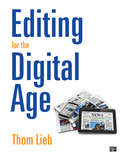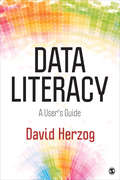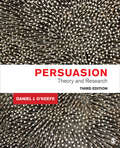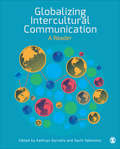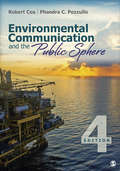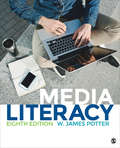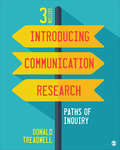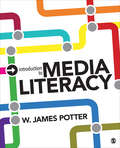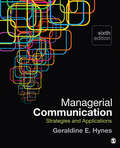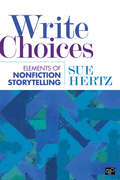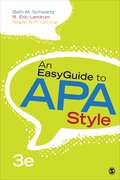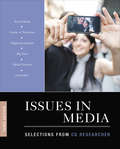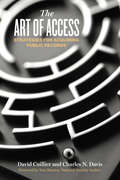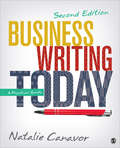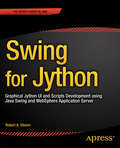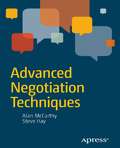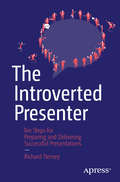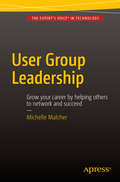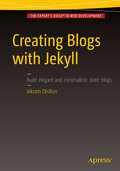- Table View
- List View
Editing for the Digital Age (20160101 #05 College/higher education)
by Thom LiebA Balanced Approach for the Modern Writer and Editor Whether working in a traditional newsroom or as a one-person blogging operation, every good writer needs to become his or her own best editor. Editing for the Digital Age provides editors and writers with the tools necessary to ensure that published material is accurate, readable, and complete. The book provides guidance in copy editing fundamentals, including correcting grammar, conforming the writing to a style guide, and revising material so that it is tightly written and clear. The text is designed for today’s digital publishing landscape and addresses the many issues writers and editors now face on a daily basis—handling legal issues such as liability, copyright, and libel; writing headlines that will attract readers; creating multimedia packages to support an article or post; and using various forms of social media to curate content and connect with audience members. Chapters focus on key areas and themes for editing in the digital age, and "Write Right" writing and grammar exercises are woven into every chapter to progressively build students’ editing skills.
Editing for the Digital Age (20160101 #05 College/higher education)
by Thom LiebA Balanced Approach for the Modern Writer and Editor Whether working in a traditional newsroom or as a one-person blogging operation, every good writer needs to become his or her own best editor. Editing for the Digital Age provides editors and writers with the tools necessary to ensure that published material is accurate, readable, and complete. The book provides guidance in copy editing fundamentals, including correcting grammar, conforming the writing to a style guide, and revising material so that it is tightly written and clear. The text is designed for today’s digital publishing landscape and addresses the many issues writers and editors now face on a daily basis—handling legal issues such as liability, copyright, and libel; writing headlines that will attract readers; creating multimedia packages to support an article or post; and using various forms of social media to curate content and connect with audience members. Chapters focus on key areas and themes for editing in the digital age, and "Write Right" writing and grammar exercises are woven into every chapter to progressively build students’ editing skills.
Data Literacy: A User′s Guide
by David L. HerzogA practical, skill-based introduction to data analysis and literacy We are swimming in a world of data, and this handy guide will keep you afloat while you learn to make sense of it all. In Data Literacy: A User′s Guide, David Herzog, a journalist with a decade of experience using data analysis to transform information into captivating storytelling, introduces students and professionals to the fundamentals of data literacy, a key skill in today’s world. Assuming the reader has no advanced knowledge of data analysis or statistics, this book shows how to create insight from publicly-available data through exercises using simple Excel functions. Extensively illustrated, step-by-step instructions within a concise, yet comprehensive, reference will help readers identify, obtain, evaluate, clean, analyze and visualize data. A concluding chapter introduces more sophisticated data analysis methods and tools including database managers such as Microsoft Access and MySQL and standalone statistical programs such as SPSS, SAS and R.
Data Literacy: A User′s Guide
by David L. HerzogA practical, skill-based introduction to data analysis and literacy We are swimming in a world of data, and this handy guide will keep you afloat while you learn to make sense of it all. In Data Literacy: A User′s Guide, David Herzog, a journalist with a decade of experience using data analysis to transform information into captivating storytelling, introduces students and professionals to the fundamentals of data literacy, a key skill in today’s world. Assuming the reader has no advanced knowledge of data analysis or statistics, this book shows how to create insight from publicly-available data through exercises using simple Excel functions. Extensively illustrated, step-by-step instructions within a concise, yet comprehensive, reference will help readers identify, obtain, evaluate, clean, analyze and visualize data. A concluding chapter introduces more sophisticated data analysis methods and tools including database managers such as Microsoft Access and MySQL and standalone statistical programs such as SPSS, SAS and R.
Persuasion: Theory and Research
by Daniel J. O'KeefePersuasion: Theory and Research, Third Edition is a comprehensive overview of social-scientific theory and research on persuasion. Written in a clear and accessible style that assumes no special technical background in research methods, the Third Edition has been thoroughly revised to reflect developments in persuasion studies. New discussions of subjects such as reactance and the use of narratives as vehicles for persuasion, revised treatments of the theories of reasoned action and planned behavior, and two new chapters on social judgment theory and stage models provide your students with the most current work on persuasion in a clear, straightforward manner. In this edition, author Daniel J. O'Keefe has given special attention to the importance of adapting (tailoring) messages to audiences to maximize persuasiveness. Each chapter has a set of review questions to guide students through the chapter’s material and quickly master the concepts being introduced.
Globalizing Intercultural Communication: A Reader
by Kathryn Sorrells Sachi SekimotoTranslating Theory into Practice Globalizing Intercultural Communication: A Reader introduces students to intercultural communication within the global context, and equips them with the knowledge and understanding to grapple with the dynamic, interconnected and complex nature of intercultural relations in the world today. This reader is organized around foundational and contemporary themes of intercultural communication. Each of the 14 chapters pairs an original research article explicating key topics, theories, or concepts with a first-person narrative that brings the chapter content alive and invites students to develop and apply their knowledge of intercultural communication. Each chapter’s pair of readings is framed by an introduction highlighting important issues presented in the readings that are relevant to the study and practice of intercultural communication and end-of-chapter pedagogical features including key terms and discussion questions. In addition to illuminating concepts, theories, and issues, authors/editors Kathryn Sorrells and Sachi Sekimoto focus particular attention on grounding theory in everyday experience and translating theory into practice and actions that can be taken to promote social responsibility and social justice.
Environmental Communication and the Public Sphere
by J. Robert Cox Dr Phaedra C. PezzulloThe Fourth Edition of Environmental Communication and the Public Sphere remains the only comprehensive introduction to the growing field of environmental communication, ranging from an historical overview of key terms to important legal and technological developments. This innovative book focuses on how human communication influences the way we perceive and act in the environment. It also examines how we interpret environmental “problems” and decide what actions to take with regard to the natural world. Three-time president of the Sierra Club, the largest environmental group in the United States, lead author Robert Cox leverages his vast experience to offer insights into the news media, Congress, environmental conflict, advocacy campaigns, and other real-world applications of environmental communication. New coauthor Phaedra Pezzullo brings two decades of applied experience working with grassroots environmental justice and health organizations, citizen advisory boards, and student-led campaigns, as well as her internationally recognized research on toxic pollution, social injustices, public advocacy, and more. The authors introduce the reader to the major areas, terms, and debates of this evolving field. The Fourth Edition incorporates major revisions that include four new chapters on visual and popular culture, digital media and activism, the sustainability of college and corporation campuses, and the legal “standing” of citizens and nature. Updates throughout the text draw on timely topics including visual communication used in climate science campaigns, fracking and challenges to the right to know, plastic bag bans, consumer apps, digital activism for environmental justice, green marketing, and arguments on giving legal rights to nonhuman entities from dolphins to rivers.
Media Literacy
by Dr W. James PotterIn this media-saturated world, we must learn how to navigate through the overwhelming flood of information so we can avoid the risks and maximize its potential to help us. Media Literacy, Eighth Edition shows readers how. Drawing from thousands of media literature studies, bestselling author W. James Potter explores the key components to understanding the fascinating world of mass media. In this updated, revised, and reorganized new edition, Potter presents numerous examples and facts for readers to understand how the media operate, how they attract attention, and how they influence us on a day-to-day basis.
Media Literacy
by Dr W. James PotterIn this media-saturated world, we must learn how to navigate through the overwhelming flood of information so we can avoid the risks and maximize its potential to help us. Media Literacy, Eighth Edition shows readers how. Drawing from thousands of media literature studies, bestselling author W. James Potter explores the key components to understanding the fascinating world of mass media. In this updated, revised, and reorganized new edition, Potter presents numerous examples and facts for readers to understand how the media operate, how they attract attention, and how they influence us on a day-to-day basis.
Introducing Communication Research: Paths of Inquiry
by Donald F. TreadwellIntroducing Communication Research: Paths of Inquiry helps students understand the communication research process from start to finish. The Third Edition has been updated throughout to explain the Internet and social media as tools and topics for communication research. Streamlined, accessible, and with campus-based research examples that students can relate to, this text guides students through the fundamentals of conducting research and presenting research findings for scholarly, professional, news/media, and web audiences.
Introduction to Media Literacy
by W. James PotterIntroduction to Media Literacy builds students’ media literacy step-by-step to make them more knowledgeable and engaged producers and consumers of media. In nine streamlined chapters, students learn how the mass media operate and how to use the media in better ways to achieve their own personal goals. All of the essential media topics are covered—from understanding media audiences, industries, and effects to confronting controversies like media ownership, privacy, and violence—in a concise format that keeps students focused on effectively improving their media literacy skills. Give your students the SAGE edge! SAGE edge offers a robust online environment featuring an impressive array of free tools and resources for review, study, and further exploration, keeping both instructors and students on the cutting edge of teaching and learning.
Introduction to Media Literacy
by W. James PotterIntroduction to Media Literacy builds students’ media literacy step-by-step to make them more knowledgeable and engaged producers and consumers of media. In nine streamlined chapters, students learn how the mass media operate and how to use the media in better ways to achieve their own personal goals. All of the essential media topics are covered—from understanding media audiences, industries, and effects to confronting controversies like media ownership, privacy, and violence—in a concise format that keeps students focused on effectively improving their media literacy skills. Give your students the SAGE edge! SAGE edge offers a robust online environment featuring an impressive array of free tools and resources for review, study, and further exploration, keeping both instructors and students on the cutting edge of teaching and learning.
Managerial Communication: Strategies and Applications
by Geraldine E. HynesA Practical, Strategic Approach to Managerial Communication Managerial Communication: Strategies and Applications focuses on communication skills and strategies that managers need in today’s workplace. This book continues to be the market leader due to its strategic approach, solid research base, comprehensive coverage, balanced examination of oral and written communication, and focus on managerial, not entry-level, competencies. In the Sixth Edition, author Geraldine E. Hynes preserves the book’s key strengths while reflecting the realities of the contemporary workplace.
Environmental Conflict Management
by Tarla Rai Peterson Tracy Lee ClarkeA step-by-step guide connecting theory to practice Environmental Conflict Management introduces students to the research and practice of environmental conflict and provides a step-by-step process for engaging stakeholders and other interested parties in the management of environmental disputes. In each chapter, authors Dr. Tracylee Clarke and Dr. Tarla Rai Peterson first introduce a specific concept or process step and then provide exercises, worksheets, role-plays, and brief case studies so students can directly apply what they are learning. The appendix includes six additional extended case studies for further analysis. In addition to providing practical steps for understanding and managing conflict, the text identifies the most relevant laws and policies to help students make more informed decisions. Students will develop techniques for public involvement and community outreach, strategies for effective meeting management, approaches to negotiating options and methodologies for communicating concerns and working through differences, and outlines for implementing and evaluating strategies for sustaining positive community relations.
Write Choices: Elements of Nonfiction Storytelling
by Susan Sue HertzDeveloping nonfiction writers at any stage of their career Write Choices: Elements of Nonfiction Storytelling helps writers cultivate their nonfiction storytelling skills by exploring the universal decisions writers confront when crafting any kind of factual narrative. Rather than isolating various forms of narrative nonfiction into categories or genres, Sue Hertz focuses on examining the common choices all true storytellers encounter, whether they are writing memoir, literary journalism, personal essays, or travel essays. And since today’s writers are no longer confined to paper, Write Choices also includes digital storytelling options, and how writers can employ technology to enhance their narratives. Integrating not only her own insights and experience as a journalist, nonfiction book author, and writing instructor, but also those of other established nonfiction storytellers, both print and digital, Hertz aims to guide writers through key decisions to tell the best story possible. Blending how-to instruction with illuminating examples and commentaries drawn from original interviews with master storytellers, Write Choices is a valuable resource for all nonfiction writers, from essayists to memoirists to literary journalists, at any stage of their career.
An Easy Guide to APA Style
by Beth M. Schwartz R. Eric Landrum Regan A. R. GurungWritten by experienced psychology instructors Beth M. Schwartz, R. Eric Landrum, and Regan A. R. Gurung, all active and respected members of the American Psychological Association (APA) Society for the Teaching of Psychology, the updated Third Edition of An Easy Guide to APA Style provides a reader-friendly guide for mastering APA style and covers all sections of an APA-style paper. Clear, conversational, and humorous, the book presents easy-to-understand explanations of how to write research papers, term papers, and lab reports, and cite references following APA style and format. The authors focus on the most essential elements of APA style and format, offering useful advice, tips, and visual representations.
Issues in Media: Selections from CQ Researcher
by Cq ResearcherWhat is the future of television? What is the impact of media violence on society? Is news quality better or worse online? Should we regulate internet and social media use, and if so, how? Will traditional print books disappear from the marketplace? These are just a sampling of the important, provocative questions in this new reader, sure to provide a solid foundation to spark lively classroom discussion. For current coverage of controversial and important issues centering on media, look to the balanced reporting, complete overviews and engaging writing that CQ Researcher has consistently provided for more than eighty years. This brief reader allows students to see the links between media, culture, business and politics, and an opportunity to view the issues from all sides while giving them a window into the relationships between media, culture, business, and politics. In addition, useful pedagogical features—pro/con debates, graphs, tables, photos, suggested readings, and bibliographies—advance critical thinking and help in study and review.
Issues in Media: Selections from CQ Researcher
by Cq ResearcherWhat is the future of television? What is the impact of media violence on society? Is news quality better or worse online? Should we regulate internet and social media use, and if so, how? Will traditional print books disappear from the marketplace? These are just a sampling of the important, provocative questions in this new reader, sure to provide a solid foundation to spark lively classroom discussion. For current coverage of controversial and important issues centering on media, look to the balanced reporting, complete overviews and engaging writing that CQ Researcher has consistently provided for more than eighty years. This brief reader allows students to see the links between media, culture, business and politics, and an opportunity to view the issues from all sides while giving them a window into the relationships between media, culture, business, and politics. In addition, useful pedagogical features—pro/con debates, graphs, tables, photos, suggested readings, and bibliographies—advance critical thinking and help in study and review.
The Art of Access: Strategies for Acquiring Public Records
by Charles Davis David L. CuillierWhatever you're trying to learn about the world—as a journalist or as an informed citizen— public records often hold the key. But what records, where? And how to get them? It starts with understanding the Freedom of Information Act, but what you really need are strategies for dealing with the officials who stand between you and the information you seek. Gaining access to records is an art, one that requires an organized approach and a good understanding of human behavior.
Business Writing Today: A Practical Guide
by Natalie CanavorConfident writers succeed. Whether you aim for a career in the business, nonprofit or government world, good writing equips you to stand out. In this accessible and reader-friendly book, Natalie Canavor shares a step-by-step framework to help you write strategically, win opportunities, and perform better on the job. You’ll know what to say and how to say it in any medium from email to blog, cover letter, proposal, resume, report, website, tweet, news release, and more. You’ll discover practical, grammar-free techniques to improve all your writing and learn how to recognize and fix your own problems with clear demonstrations. Business Writing Today, Second Edition, gives you tools, techniques and inside tips drawn from the worlds of journalism, corporate communications and public relations. It prepares you to better understand the business world and communicate in ways that achieve your own immediate and long range goals in today’s highly competitive work environment.
Swing for Jython
by Robert A. GibsonThis book shows you how to use Swing to add a GUI to your Jython scripts, with an emphasis on the WebSphere Application Server wsadmin utility. In fact, we're going to teach you Swing using Jython, and we're going to do it in a way that, hopefully, that makes your scripts easier for people to use, more robust, more understandable, and therefore easier to maintain.
Advanced Negotiation Techniques
by Alan Mccarthy Steve HayAdvanced Negotiation Techniques provides a wealth of material in a winning combination of practical experience and good research to give you a series of tools, techniques, and real-life examples to help you achieve your negotiation objectives. For 25 years and across 40 countries, the Resource Development Centre (RDC), run by negotiation experts Alan McCarthy and Steve Hay, has helped thousands of people to conduct successful negotiations of every type. Many RDC clients have been business professionals who have learned how to sell more successfully. Others have improved their buying skills. A few clients have applied the RDC techniques outside the business environment altogether--for instance, in such areas as international diplomatic services, including hostage and kidnap situations. As you'll discover, the RDC philosophy is centered on business ethics and a principled approach to negotiation that maximizes the value of the outcomes for both parties. It can even create additional value that neither party could find in isolation. In this book, you will learn: The ten golden rules for successful negotiationsHow to handle conflicts with your negotiating partnersWhat hostage and kidnapping negotiations can teach managers negotiating in business settingsHow to ensure both sides perceive any agreement as a 'win'Achieve higher-profit deals in difficult circumstancesIn the business world, negotiating with other companies, government officials, and even your colleagues is a fact of life. Advanced Negotiation Techniques takes you through a system for planning and conducting negotiations that will enable you and your team to achieve your negotiation objectives. This is an internationally tried and tested process, with many current Blue Chip organizations applying it daily for a simple reason: the techniques are easy to implement and they work. That makes this book essential reading for those who want to achieve their goals in any area of life.
The Introverted Presenter
by Richard TierneyThe introvert is a personality type that draws energy from the outside inward. According to standard personality testing assessments, most people are introverts and no group is more introverted than technical professionals. Introverts are congenitally programmed to recoil from the prospect of public speaking with fear and loathing, yet making presentations to expert and non-expert audiences is an inescapable requirement for career advancement in any technical field. Presentation coach Richard Tierney rides to the rescue of fellow introverts in the IT and engineering sectors with The Introverted Presenter--his fail-safe guide to delivering competent presentations, no matter how unsuited by nature you might be to the performing arts. This short book lays out the complete process guaranteed to raise you from a debilitating state of terror and aversion to a comfortable place of clarity, calm, and competence--perhaps even brilliance, if you can train yourself to convert the free energy of your fear into controlled performance. Tierney repeatedly warns his introvert readers that they risk presentation fiasco if they skip, skimp, or change the order of any of the ten steps he prescribes for thoroughly and efficiently preparing their presentations. The surefire sequence of steps for The Introverted Presenter begins with defining your presentation''s audience and objective. The next step is to write the script of your speech in stages, constructing it on the basis of proven structural rules, cognitive laws, and dramatic tricks. Then you incrementally refine and tighten your script by delivering it iteratively, first in front of a mirror and then in front of increasingly critical test audiences, progressing from your cat to your boss. When you have a well-constructed and sound-tested script in hand and only then, you may create some slides to graft into your script in support of your opening action call and your concluding takeaways, which you commit to memory. Your slides should be limited to the smallest number possible (even zero) and the fewest possible words. What you''ll learn By following the process precisely as described in this book, even the most introverted technology professional will gradually but surely acquire the ability to Structure a killer presentation Coach yourself into being the best performer you can be Craft a presentation that supplies your audience''s technical needs while activating its human sympathies Use slides sparingly for best supporting effect Deploy elements of stagecraft like a trouper Who this book is for The primary readership is technology professionals who ordinarily shun the public-speaking limelight but find they need to pitch their work outside their team environments. The secondary readership is non-extroverts in the corporate, commercial, or academic worlds who have taken career promotions that involve presentations as part of their job descriptions. Table of Contents Chapter 1. Introverts and Presentations: Harnessing Terror Chapter 2. Face the Presentation Specter: Feared More Than Death Chapter 3. Find Your Presentation''s Focus: Ready, Steady Chapter 4. Impose Your Presentation''s Structure: Taking the Reins Chapter 5. Write Your Speech: Fear Returns Chapter 6. Refine Your Speech: Relishing the Panic Chapter 7. Try On Your Presenting Persona: Trotting the Course Chapter 8. Master Your Presentation Technology: Bending the Servant to Your Will Chapter 9. Chunk Your Presentation: Linking Primacy, Latency, and Failsafe Devices Chapter 10. Rehearse Your Presentation: Practice, Practice till Thoroughly Bored Chapter 11. Deliver Your Presentation: Treading the Hustings Like a Trouper Chapter 12. Encore! Rolling On to Your Next Presentation Chapter 13. Instant Clarity: Scaring Up an Emergency Presentation in One Day
User Group Leadership
by Michelle MalcherThis book is about starting and sustaining a technology user group. User groups are a wonderful way to connect with local and like-minded professionals for networking and learning. All the forums and social media on the internet can't replace face-to-face time spent discussing problems, upcoming technologies, and other pertinent topics. What every user group needs is leaders to organize meetings, find speakers, and connect the community. What every leader needs is good advice and guidance on how to begin a group and nurture new leadership to keep the group sustainable, and Michelle Malcher provides just that right sort of guidance in her book on User Group Leadership. This book is designed to help you understand what goes into starting and building a user group, giving you the tools and resources to do so. Learn what to expect before your first meeting, in the first three months, and in the first year. Malcher has experience from the local group level on up to the international level with the Independent Oracle User Group. If you're involved in technology and are ready to take on a position of leadership by which to help others network, succeed, and grow, then grab a copy of this book. You won't find a better source of guidance for starting and growing a new group on the technology of your choice. Learn what to know before you ever have your first meeting Prepare for each meeting with a list of things that should be done Grow your local members into future leaders What you'll learn Choose the right motivations for starting a group Build a governance structure and integrate with an umbrella group Locate and book interesting speakers Recruit help to share the administrative burden Grow the next generation of leadership Make a difference in people's careers by helping them grow and network and learn Who this book is for User Group Leadership is aimed at technology professionals interested in networking and learning with like-minded people in their same technology area. The book is especially aimed at the ambitious professional who is ready to step into a leadership role by creating a vibrant user community where no such community currently exists, but one is needed. Table of Contents 1. Development of a User Group 2. User Group Governance 3. Building Leaders and Volunteers 4. User Group Planning 5. User Group Members 6. Challenges 7. Career Development 8. From Techie to Leader 9. Qualities of a User Group Leader 10. Qualities of a User Group Volunteer
Creating Blogs with Jekyll
by Vikram DhillonLearn to create your own blog using the Jekyll static site generator. You'll start with a simple template, add new features to it, automate any maintenance, attach social sharing, and begin writing. By the end of Creating Blogs with Jekyll, you will be able to create custom blogs with Jekyll, update the content with ease, and reach out to your readers with minimal effort. Because you've built your blog yourself, you'll know exactly how each component works, and you won't be dependent on an admin panel to maintain it. Creating Blogs with Jekyll equips you with the knowledge to create an elegantly designed blog and scale it to capture more readers. Recapture the magic of writing by creating great content and use an easy workflow in Jekyll to maintain it for blogging. Do new things and write about them in style with Jekyll. Takes you through building a fully functional blog from scratch using Jekyll Provides a fun way to work on a side-project and integrate cutting edge web technologies Teaches you how to update and maintain your awesome blog Jekyll is a simple, secure and very low maintenance blog engine that converts naturally written content in markdown into a beautiful and minimal blog. It allows you to focus on content creation and expressing yourself instead of spending all your time updating the plugins and maintaining the database. Jekyll does not rely on a database as a backend so your blog will be far more secure and reliable than any traditional blogging engines such as WordPress. We live in a day and age where short attention spans make it very difficult to expose a reader to interesting content. What better way to capture a reader's attention and retain viewers by captivating them by your own unique style and taste? Jekyll allows the content to shine with minimal distractions and a greater focus on the content and easy sharing of the content. What you'll learn Choose a base theme appropriate for your style and development Integrate various web technologies that will work well together and enhance your blog Automate social sharing components and comments workflow Make adjustments to themes, views and styles of blog posts Update any of the modular components of the blog and integrate new technologies Implementing Jekyll and deploying static websites for future projects Who this book is for Creating Blogs with Jekyll is for the developer who is ready to move beyond the complexities of maintaining a content management system by creating their own unique blog in their own style. It's for the project manager tired of spending all their time editing their blog on the admin panel and updating the content management system. Creating Blogs with Jekyll is an excellent choice for new developers to start blogging because of the simplicity of Jekyll's theming layer and writing workflow. It's an excellent choice for the web developer wanting to build their blog from scratch and expand their knowledge of higher level web technologies.
